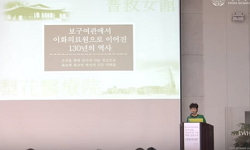Since the Gulf War, war as we know it has undergone a great deal of change due to the rapid development of Military Technology. The countries around the Korean Peninsula are pursuing a new paradigm of military security policy that would ensure them bo...
http://chineseinput.net/에서 pinyin(병음)방식으로 중국어를 변환할 수 있습니다.
변환된 중국어를 복사하여 사용하시면 됩니다.
- 中文 을 입력하시려면 zhongwen을 입력하시고 space를누르시면됩니다.
- 北京 을 입력하시려면 beijing을 입력하시고 space를 누르시면 됩니다.
https://www.riss.kr/link?id=T8552517
- 저자
-
발행사항
[서울] : 中央大學校 行政大學院, 2000
-
학위논문사항
학위논문(석사) -- 中央大學校 行政大學院 , 安保政策 , 2000. 8
-
발행연도
2000
-
작성언어
한국어
- 주제어
-
KDC
349
-
발행국(도시)
서울
-
형태사항
iii, 63 p. ; 26 cm.
- DOI식별코드
- 소장기관
-
0
상세조회 -
0
다운로드
부가정보
다국어 초록 (Multilingual Abstract)
Since the Gulf War, war as we know it has undergone a great deal of change due to the rapid development of Military Technology. The countries around the Korean Peninsula are pursuing a new paradigm of military security policy that would ensure them both survival and prosperity for the degree of Master of the Public Administration.
The general trend, including that of the neighboring strong powers, is to establish a new objective and mission, and revamp the overall military system so as to accomplish them. The so-called Military Technical Revolution is being pursued to slim the external military force and to accomplish the qualitative enhancement of the military based on High Technology. In addition, the change of the domestic and international environment is rendering inevitable a drastic change in the construction of military power in a way that will be adequate to the integration of South/ North Militaries, and the establishment of a Defense Policy and Military Strategy befitting the new unified environment.
This paper projects the security environment of the 21st century, analyzes the security environment in and around the Korean Peninsula after the unification of the two Koreas, and presents the military strategy that will guide the construction and employment of the military of the unified Korea.
It asks first, what are the basic theories and concepts related to the formulation of a military strategy? Second, what are the domestic and international factors of security environment of the Korean Peninsula in the 21st century and how will they evolve? Fourth, based on this, what military strategy would be suitable to the strategic environment of the unified Korea?
This paper consists of 5 chapters. The first chapter brings up the questions and states the objective, scope, and method of the study. Chapter 2 looks into the concept and essence of strategy, the scope of military strategy, the formation and types which are needed in formulating military strategy. Chapter 3 classifies the features of the security environment of the 21st century into domestic and international environment factors.
The international factors comprise the military policy of the neighboring four powers towards the Korean Peninsula, the innovation in science and military technology, the evolution of future wars and strategic environment. The domestic factors include the outlook on the politics, economics, and military of the unified Korea. Based on this analysis, Chapter 4 presents the direction of the military strategy of the unified Korea. In particular, this chapter presents the direction of the development of military strategy that befits the military strategic environment of the unified Korea based on the analyses of chapters 2 and 3.
The analysis on the state of affairs after the unification of the Korean Peninsula leads us to the conclusion that states will be pursuing their exclusive self-interests -primarily economic interests- and that the instability of the international system will be augmented due to multipolarity. Such instability is anticipated to increase the possibility of regional conflict arising from feuds in economics, ethnicity, culture, and religion.
The construction of military power and strategic thinking embraces the concept of total deterrence and flexible countermeasure strategy. This concept has as its basic philosophy self-reliant omnidirectional military capability and the construction of deterrence by national total war system and the accomplishment of the military objective of the defense of the forefront through immediate response posture based on self-reliant combined strategy and deterrence strategy by total war.
To this end, it is imperative to maintain a military befitting an independent nation with self-defense capability. Also, in order to be able to respond to Future Wars, the structure of the military should be transformed into a Small but Strong Military that is efficient and organized according to the functions and that is able to rapidly respond to emergencies under the Joint Forces System.
Thus the overall Military Forces should be classified into structured and elite Air, Sea, Ground Forces and bestow upon them their priorities and roles. It is also needed to reorganize the roles of the Forces and develop the Force structure stage by stage.
목차 (Table of Contents)
- 第1章 序論 = 1
- 第1節 硏究目的 = 1
- 第2節 硏究範圍및 硏究方法 = 3
- 第2章 軍事戰略의 理論的分析의 틀 = 5
- 第1節 安保環境分析의 틀 = 5
- 第1章 序論 = 1
- 第1節 硏究目的 = 1
- 第2節 硏究範圍및 硏究方法 = 3
- 第2章 軍事戰略의 理論的分析의 틀 = 5
- 第1節 安保環境分析의 틀 = 5
- 第2節 軍事戰略의 槪念과 構成 = 8
- 第3章 2 1세기 韓半島安保環境의 전망 = 11
- 第1節 外部環境要因分析 = 11
- 1. 周邊國의 對韓半島戰略 = 11
- 2. 科學및 軍事技術의 革新 = 20
- 3. 未來戰및 戰略環境의 變化 = 22
- 第2節 內部環境要因分析 = 26
- 1. 統一韓國의 政治 = 26
- 2. 統一韓國의 經濟 = 26
- 3. 統一韓國의 軍事 = 27
- 第4章 統一韓國의 軍事戰略發展方向 = 30
- 第1節 軍事目標 = 31
- 第2節 軍事戰略 = 34
- 1. 安保政策 = 34
- 2. 軍事戰略의 基調 = 36
- 3. 統一韓國의 軍事戰略 = 39
- 第3節 軍事資源 = 42
- 1. 軍事力과 戰力構造 = 43
- 2. 軍事力建設方向 = 47
- 第5章 結論 = 51
- 參考文獻 = 56
- ABSTRACT = 61












